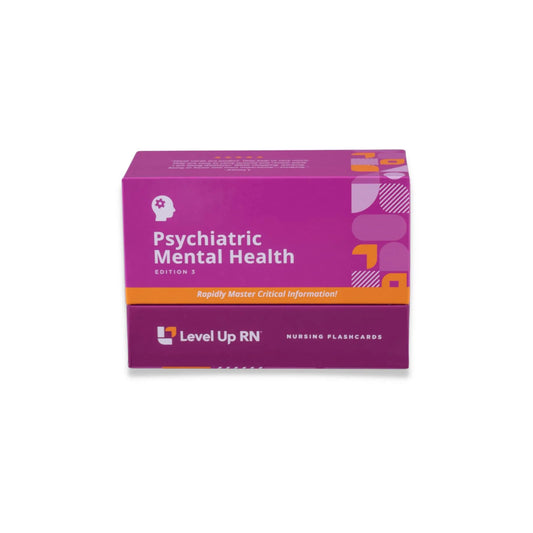In this article and video, we cover types of bipolar disorder, symptoms of mania and depression, treatment of bipolar disorder, and nursing care of patients with bipolar disorder.
This series follows along with our Psychiatric Mental Health Nursing Flashcards which are intended to help RN and PN nursing students study for nursing school exams, including the ATI, HESI, and NCLEX.
Psychiatric Mental Health - Nursing Flashcards
Bipolar disorder is a mental health disorder characterized by mood swings, including periods of mania or hypomania and periods of depression.
Types of bipolar disorder
The types of bipolar disorder you need to know about for your nursing exams include Bipolar I, Bipolar II, and cyclothymic disorder.
Bipolar I disorder
Bipolar I includes episodes of severe mania and depression.
Bipolar II disorder
Bipolar II includes periods of hypomania and periods of depression.
What is hypomania?
Hypomania is a milder form of mania. Hypo- means below, less, or slow. So hypomania is a level of mania that's below or less than regular mania. It's not as severe.
Cyclothymic disorder
Cyclothymic disorder includes periods of hypomanic and depressive symptoms, lasting more than 2 years.
Mania
Mania is excessive excitement, enthusiasm, energy and/or overactivity.
Mania signs and symptoms
When a patient is experiencing mania, they are very talkative, very excited, and have racing thoughts. They are easily distracted and they have a hard time staying still.
During manic episodes, patients may demonstrate poor judgment or engage in detrimental behaviors, like unsafe sex or excessive spending. During mania, patients may also have decreased appetite and decreased sleep, which places them at risk for malnutrition and exhaustion.
Cathy's experience with a patient in a manic episode
Reading about or hearing about the symptoms of mania is one thing, seeing it in action is another.
As Cathy shares in the video, she worked in a behavioral health unit for her clinicals. And she got to speak with a patient who was experiencing mania.
At first, it wasn't obvious that anything was wrong. Cathy's patient was very talkative and very friendly. But the longer Cathy talked to her, she just didn't stop. She didn't "come up for air." And she would change the subject every minute or less.
Cathy felt there was no way she could get a word in edgewise or ask any questions because the patient wasn't stopping—"It was like she was going 150 miles an hour."
Cathy noted that it felt exhausting to talk to her. So she knew the patient herself must be exhausted in that manic state.
Depressive signs and symptoms
During periods of depression, patients may have symptoms such as a flat affect (tone, perceptible mood, an/ord facial expressions), slow speech, minimal movements, anhedonia (lack of pleasure), negative thoughts, as well as a feeling of hopelessness or worthlessness.
Bipolar disorder diagnostic criteria
Bipolar disorder is diagnosed when a patient's mood episodes impact their ability to function or impacts their social or occupational environments.
It's important to rule out any other causes of the patient's symptoms, which can include substance use, or an underlying disorder like thyroid dysfunction.
Bipolar disorder treatment
In terms of treatment, medications that are used to treat bipolar disorder include mood stabilizers as well as atypical antipsychotics.
Other therapy options include cognitive behavioral therapy as well as electroconvulsive therapy.
Or, Assertive Community Treatment (ACT), which is particularly helpful for patients who have persistent and severe bipolar disorder. ACT involves a multidisciplinary approach that focuses on treating the patient in the community and it helps to prevent hospitalizations and other complications.
Bipolar disorder nursing care
Nursing care of a patient with bipolar disorder is important to know for your nursing school exams.
As the nurse, you should decrease stimuli, remove dangerous items from the environment, remain calm, and set clear limits. Monitor your patient's intake and output, as well as their sleep patterns, due to the risk for malnutrition and sleep deprivation.
You can provide high-protein, high-calorie finger foods that can be eaten on the go. This helps to ensure patients are meeting their caloric requirements in an easier-to-manage way.
Finally, protect your patient from poor judgment— including unsafe sexual practices, or excessive spending.


